Original | Odaily Planet Daily (@OdailyChina_)
_
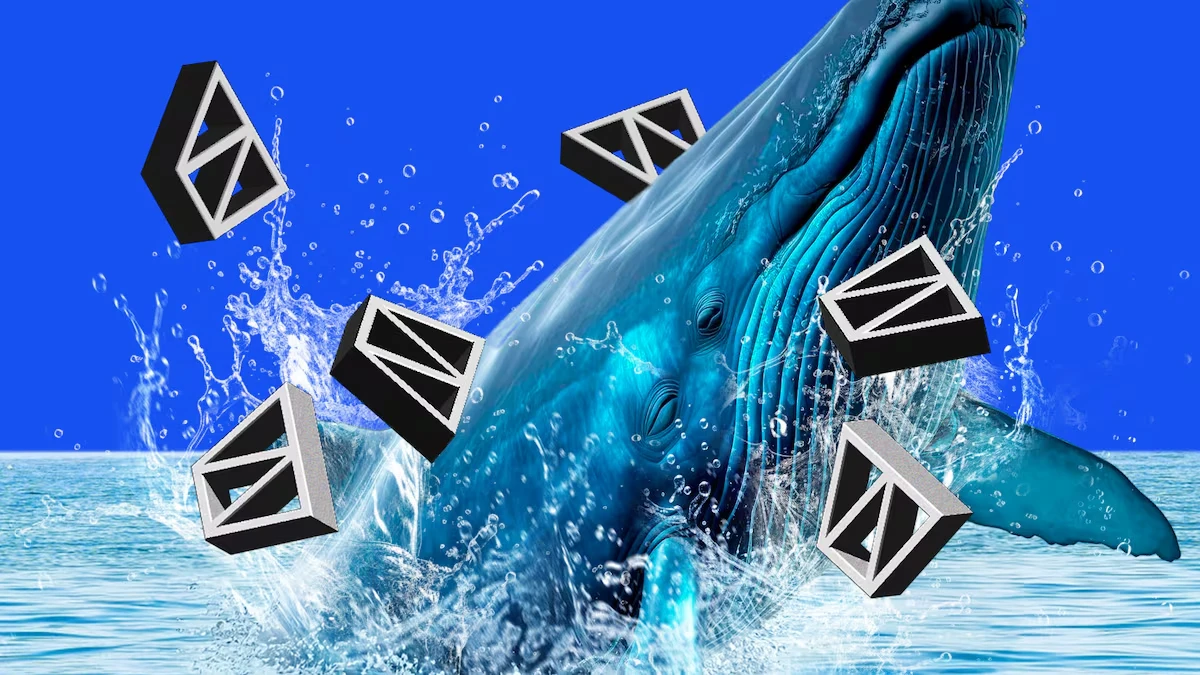
On July 22, according to insiders, the crypto prediction market platform Polymarket is evaluating the possibility of launching its own stablecoin, aiming to control the profits generated from the substantial reserves backed by Circle's USDC. Although Polymarket has not made a final decision, combined with the recent conclusion of the U.S. Department of Justice's investigation into Polymarket and the platform's acquisition of the U.S. compliant trading platform QCX, many users speculate that Polymarket's token issuance is on the way, thus increasing their interaction frequency.
Rumors about Polymarket's token issuance have been mentioned since 2024, leading to studios interacting in bulk for nearly a year. So, for users who have never interacted with Polymarket or have done so infrequently, is it still necessary and timely to start using Polymarket now?
Polymarket Remains Competitive After the U.S. Election
Before considering whether it is too late to start interacting with Polymarket, we need to understand the current operational status of the platform. Polymarket's popularity stems from the 2024 U.S. presidential election, where it gained fame for successfully predicting Trump's victory and handling up to $8 billion in betting funds. However, since the end of the U.S. election, the frequency of mentions of Polymarket in the media has begun to decline, leading to the view that Polymarket would lose a large number of users after the election prediction topic was gone. But the reality may disappoint them; the following data reveals that after the hype of the U.S. election and outside the political realm, Polymarket remains a popular platform processing tens of thousands of transactions daily and serving tens of thousands of users.
Daily Active Wallets

According to Dune data, starting from May 2024, the daily active wallets on Polymarket experienced a rise from nearly 0 to 70,000 over six months. Although there was a decline in wallet activity around the end of January to early February 2025 due to Trump's official inauguration, it rebounded afterward. Currently, the daily active wallets on Polymarket remain at 20,000 to 30,000. While this cannot be compared to the daily active users of Meme launch platforms like Pump.fun, it still surpasses Layer 2 solutions like Starknet and ZKsync. The sustained high wallet activity after the hype validates Polymarket's solid product-market fit.
Daily Transaction Count

Similarly, the daily transaction count on Polymarket peaked during the 2024 U.S. election, reaching nearly 500,000 transactions. However, even after the election cooled down, the transaction count on Polymarket remains above 100,000. This indicates that while the usage of Polymarket has decreased since the election, it still retains a significant number of loyal users compared to before 2024.
Monthly Transaction Volume
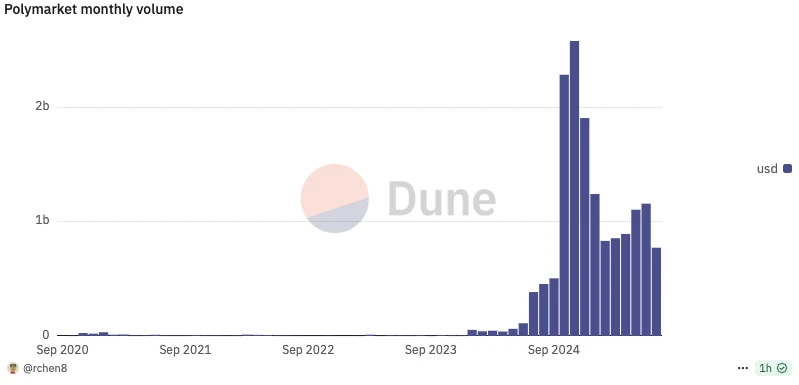
According to Dune data, the monthly transaction volume on Polymarket peaked in November 2024, reaching $2.5 billion. However, after the election, from February 2025 to the present, Polymarket still sees a monthly transaction volume of $700 million to $1.1 billion. According to DeFiLlama data, in the past 30 days, Polymarket ranked 40th in transaction volume, ahead of established DEXs like Sushi and GMX.
User Ratio Outside the U.S. Election

The above chart reflects the proportion of users who have never participated in the U.S. election market. From the chart, it can be seen that after the U.S. election, the total number of wallets is decreasing, but the number of wallets that have never participated in the U.S. election remains stable. This indicates that although Polymarket has lost a large number of short-term speculative users after the election, the number of loyal platform users has not significantly decreased. The proportion of users who have never participated in the U.S. election market is gradually increasing.
Monthly New Users
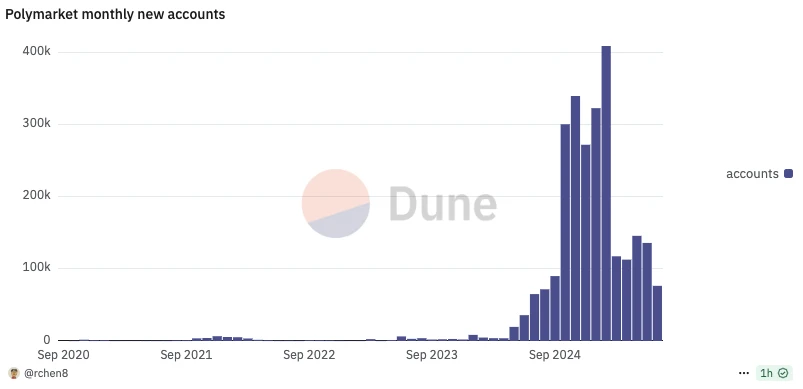
The above chart reflects the monthly new users of Polymarket. The period of the U.S. election was the time when Polymarket saw the most new users monthly, but it was also the main growth period for the platform. However, after the U.S. election, as speculators drawn in by the election left, Polymarket has maintained a growth of 110,000 to 140,000 accounts monthly since March 2025. This indicates that aside from the U.S. election, Polymarket's other prediction areas are still attracting players, and this also represents a significant shift in the user composition of the Polymarket platform from short-term speculative events to long-term usage.
Number of Prediction Pools

The above chart reflects the number of prediction pools on the Polymarket platform each month. From the chart, it can be seen that since 2025, the number of prediction pools on Polymarket each month has exceeded that during the 2024 U.S. election period. In May and June 2025, the number of prediction pools even surpassed 5,000, reaching 6,771 and 8,238 respectively. This indicates that the prediction betting areas on the Polymarket platform are continuously expanding, likely attracting more players with different interests.
Is it too late to use Polymarket now?
From the above data, it can be seen that the Polymarket platform is still relevant, and projects with such product-market fit are also highly sought after in the financing market. According to Rootdata, Polymarket has completed three rounds of financing, totaling $74 million. Additionally, according to news from June, Polymarket is seeking nearly $200 million in financing at a valuation of over $1 billion.
For an application like Polymarket that has influenced traditional political media and brought crypto into the mainstream, a $1 billion valuation is not actually high. If it does issue a token, even a 10% airdrop of the token supply to platform users could be significant. Therefore, considering whether it is too late to use Polymarket is essentially about evaluating the level of competition among platform users and various transaction costs.
Using Polymarket is Not Competitive
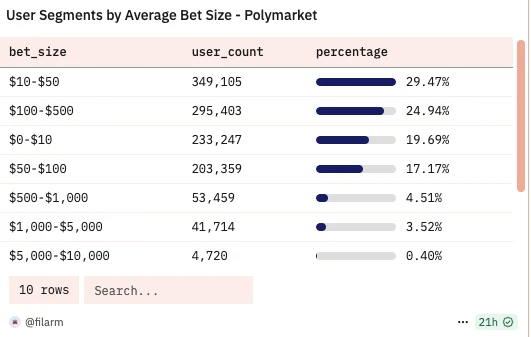
The above chart reflects the distribution of betting funds among Polymarket users. As shown, over 90% of users have betting funds below $500, while whales betting between $5,000 and $10,000 account for only 0.4%. Therefore, if there are trading rankings among the conditions for airdrops on Polymarket, it currently does not seem too difficult to rank in the top 10%. This also indirectly reflects that using Polymarket is not competitive; most users are still engaged in low-frequency, small-amount transactions.

Additionally, among the approximately 1.2 million wallets on the Polymarket platform, around 510,000 wallets have participated in more than five different markets, which is less than 50%. Participating in different markets is also considered an important dimension of interacting with Polymarket. This metric indirectly reflects the number of wallets that could qualify for a Polymarket airdrop. Combined with the previous data showing that Polymarket has 20,000 to 30,000 daily active wallets, it can be inferred that only a few tens of thousands of wallets are continuously using Polymarket. Compared to public chains that often have hundreds of thousands of interacting addresses, this is considered a "treasure protocol."
How Should Retail Investors Use Polymarket Now?
In the early years, users speculated on the dimensions that Polymarket might consider for its token airdrop:
Trading Volume
Number of Transactions
Transaction Frequency
Number of Different Markets Participated
Trading Method (Market Order, Limit Order, AMM)
Holding Time
Single Transaction Amount (e.g., at least one interaction amount greater than $500)
The above dimensions are merely a reference. As a retail investor, it may be most important to focus on trading volume, number of transactions, frequency, and holding time, while also controlling the cost of investment. For holding time, players can bet on the "2028 U.S. Presidential Election," as this prediction pool is relatively large, and the long time until settlement makes it less prone to drastic fluctuations. Additionally, there is a 4% annualized holding reward from the official source.
To boost trading volume and reduce wear, crypto blogger SIiipy shared his strategy, which involves finding a prediction pool with low liquidity and using two wallets to trade back and forth. The specific operation is shown in the image below.
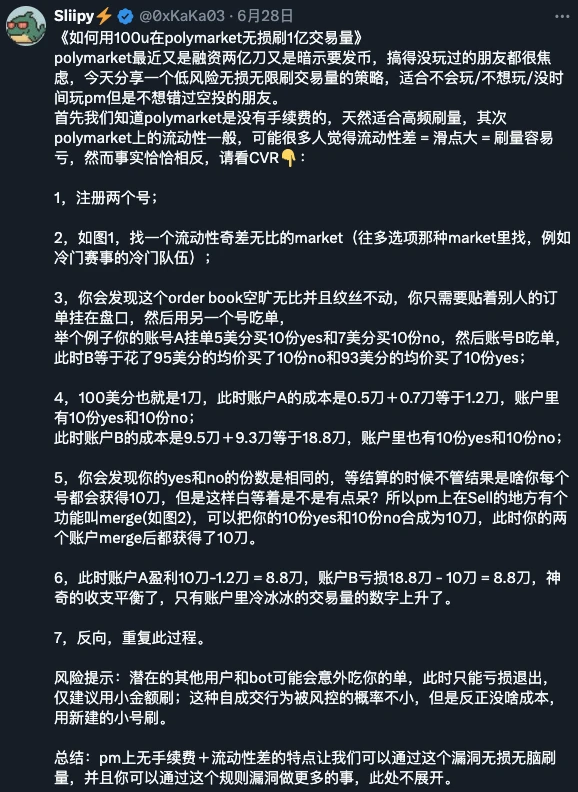
In addition to the above small, high-frequency trading, users can also choose to act as real users by making genuine bets on the Polymarket platform while vying for future airdrop opportunities. However, the principle of "nine losses out of ten bets" also applies on Polymarket. According to Dune data, only 14.3% of Polymarket users are in a profitable state, while about 86% of user accounts have negative balances.
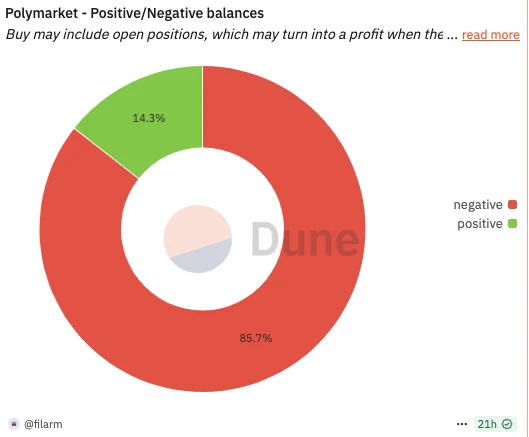
Polymarket's Positive and Negative Account Balance Ratio
Therefore, to reduce interaction costs, a new Polymarket strategy using options arbitrage has emerged. This strategy is limited to the Crypto market on Polymarket, such as the prediction pool "Will BTC fall below $118,000 on July 28?" The specific operation involves purchasing a $118,000 put option expiring on July 28 at an exchange, and then buying a "No" position on Polymarket (betting that BTC will not fall below $118,000 on July 28). This way, you provide your own hedge, but players should also be aware of the time difference risk caused by the inconsistency in settlement times between the exchange and Polymarket. (Related reading: New Strategy on Polymarket? Using Options Arbitrage)
Related Reading
1.12 Billion Dollar Breakthrough: Polymarket Returns to the U.S. via QCX Shell
免责声明:本文章仅代表作者个人观点,不代表本平台的立场和观点。本文章仅供信息分享,不构成对任何人的任何投资建议。用户与作者之间的任何争议,与本平台无关。如网页中刊载的文章或图片涉及侵权,请提供相关的权利证明和身份证明发送邮件到support@aicoin.com,本平台相关工作人员将会进行核查。




